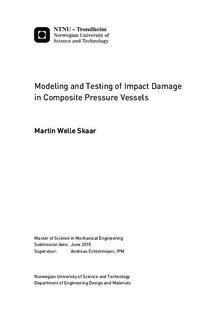Modeling and Testing of Impact Damage in Composite Pressure Vessels
Master thesis
Permanent lenke
http://hdl.handle.net/11250/2350300Utgivelsesdato
2015Metadata
Vis full innførselSamlinger
Sammendrag
Composite pressure vessels are becoming widely used for transporting gas, lately also hydrogen.In order to enable extensive use of the pressure vessels, it is critical to ensure theirsocietal acceptance, and thus safety under transportation. Being able to judge the damageof an impacted pressure vessels is one important aspect from a safety and economical pointof view. The lack of knowledge about the behaviour of damaged pressure vessels resultsin needlessly discarding damaged vessels with acceptable levels of damage.This thesis considers impact damage on glass fibre reinforced polymer pipes, produced byfilament winding. Pipe specimens were subjected to well-defined impacts for two energylevels and the damage was reproduced numerically. Interlaminar damage was modelledby cohesive elements between composite layers. Intralaminar damage was modelled bythe Hashin failure criterion on continuum shell elements.Experimental impacts produced unexpected highly asymmetrical delaminations. These delaminationswere reproducible in shape and size for all specimens. The numerical modelpredicted the asymmetrical delaminations within the scatter of the experimental resultsfor both energy levels tested. By studying the interlaminar behaviour of the delaminationin the model, the buckling mode of the pipe was found to determine the direction of delamination.The intralaminar damage (fibre failure and matrix cracking) was inconsistentfor the experimental impacts. Results ranged from no fibre damage, to large cracks withtotal fibre failure. Both the location and extent of fibre damage for the heavily damagedspecimen could be reproduced numerically. Material properties that are critical for themodelling were identified.
